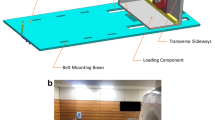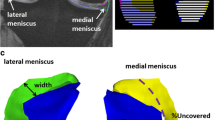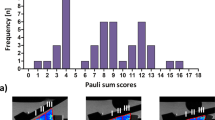Abstract
Objective
To establish a novel method of quantifying meniscal deformation using loaded MRI. More specifically, the goals were to evaluate the (1) accuracy, (2) inter-rater reliability, (3) intra-rater reliability, and (4) scan-rescan reliability. The secondary purpose of this experiment was to evaluate group differences in meniscal deformation in participants with and without radiographic knee OA.
Materials and methods
Weight-bearing 3-T MRIs of the knee in full extension and 30° of flexion were processed to create 3D models of meniscal deformation. Accuracy was assessed using a custom-designed phantom. Twenty-one participants either with or without signs of OA were evaluated, and another six participants (14 knees, one subject was scanned twice) underwent repeated imaging to assess scan-rescan reproducibility. Intraclass correlation coefficient (ICC), root-mean squared error (RMSE), and root-mean-square percent coefficient-of-variation (RMS%CV) analyses were performed. Exploratory comparisons were made between those with and without OA to evaluate potential group differences.
Results
All variables were found to be accurate with RMSE ranging from 0.08 to 0.35 mm and 5.99 to 14.63 mm2. Reproducibility of peak anterior-posterior meniscal deformation was excellent (ICC > 0.821; p < 0.013) with RMS%CV for intra-rater ranging from 0.06 to 1.53 % and 0.17 to 1.97 %, inter-rater ranging from 0.10 to 7.20 % and 3.95 to 18.53 %, and scan-rescan reliability ranging from 1.531 to 7.890 % and 4.894 to 9.142 %, for distance and area metric, respectively. Participants with OA were found to have significantly greater anterior horn movement of both the medial (p = 0.039) and lateral meniscus (p = 0.015), and smaller flexed medial meniscus outer area (p = 0.048) when compared to controls.
Conclusions
MRI-based variables of meniscus deformation were found to be valid in participants with and without OA. Significant differences were found between those with and without radiographic OA; further study is warranted.




Similar content being viewed by others
References
Lawrence RC, Felson DT, Helmick CG, et al. Estimates of the prevalence of arthritis and other rheumatic conditions in the United States. part II. Arthritis Rheum. 2008;58:26–35.
Holt HL, Katz JN, Reichmann WM, Gerlovin H, Wright EA, Hunter DJ, et al. Forecasting the burden of advanced knee osteoarthritis over a 10-year period in a cohort of 60-64 year-old US adults. Osteoarth Cart OARS Osteoart Res Soc. 2010;19(1):44–50.
Williams DP, Blakey CM, Hadfield SG, Murray DW, Price AJ, Field RE. Long-term trends in the Oxford knee score following total knee replacement. Bone Joint J. 2013;95-B(1):45–51.
Aigner T, Sachse A, Gebhard PM, Roach HI. Osteoarthritis: pathobiology-targets and ways for therapeutic intervention. Adv Drug Deliv Rev. 2006;58(2):128–49.
Wenger A, Wirth W, Hudelmaier M, Noebauer-Huhmann I, Trattnig S, Bloecker K, et al. Meniscus body position, size, and shape in persons with and persons without radiographic knee osteoarthritis: quantitative analyses of knee magnetic resonance images from the osteoarthritis initiative. Arthritis Rheum. 2013;65(7):1804–11.
Wenger A, Englund M, Wirth W, Hudelmaier M, Kwoh K, Eckstein F. Relationship of 3D meniscal morphology and position with knee pain in subjects with knee osteoarthritis: a pilot study. Eur Radiol. 2012;22(1):211–20.
Englund M, Felson DT, Guermazi A, Roemer FW, Wang K, Crema MD, et al. Risk factors for medial meniscal pathology on knee MRI in older US adults: a multicentre prospective cohort study. Ann Rheum Dis. 2011;70(10):1733–9.
Englund M, Guermazi A, Roemer FW, Yang M, Zhang Y, Nevitt MC, et al. Meniscal pathology on MRI increases the risk for both incident and enlarging subchondral bone marrow lesions of the knee: the MOST Study. Ann Rheum Dis. 2010;69(10):1796–802.
Roemer FW, Guermazi A, Hunter DJ, Niu J, Zhang Y, Englund M, et al. The association of meniscal damage with joint effusion in persons without radiographic osteoarthritis: the Framingham and MOST osteoarthritis studies. Osteoarth Cart OARS Osteoart Res Soc. 2009;17(6):748–53.
Englund M, Guermazi A, Roemer FW, Aliabadi P, Yang M, Lewis CE, et al. Meniscal tear in knees without surgery and the development of radiographic osteoarthritis among middle-aged and elderly persons: the multicenter osteoarthritis study. Arthritis Rheum. 2009;60(3):831–9.
Englund M, Guermazi A, Lohmander SL. The role of the meniscus in knee osteoarthritis: a cause or consequence? Radiol Clin N Am. 2009;47(4):703–12.
Englund M. Meniscal tear—a common finding with often troublesome consequences. J Rheumatol. 2009;36(7):1362–4.
Roemer FW, Guermazi A, Hunter DJ, Niu J, Zhang Y, Englund M, et al. The association of meniscal damage with joint effusion in persons without radiographic osteoarthritis: the Framingham and MOST osteoarthritis studies. Osteoarthritis and cartilage / OARS, Osteoarthritis Research Society. 2008.
Englund M. The role of the meniscus in osteoarthritis genesis. Rheum Dis Clin N Am. 2008;34(3):573–9.
Lohmander LS, Englund PM, Dahl LL, Roos EM. The long-term consequence of anterior cruciate ligament and meniscus injuries: osteoarthritis. Am J Sports Med. 2007;35(10):1756–69.
Paradowski PT, Englund M, Lohmander LS, Roos EM. The effect of patient characteristics on variability in pain and function over two years in early knee osteoarthritis. Health Qual Life Outcomes. 2005;3:59.
Paradowski PT, Englund M, Roos EM, Lohmander LS. Similar group mean scores, but large individual variations, in patient-relevant outcomes over 2 years in meniscectomized subjects with and without radiographic knee osteoarthritis. Health Qual Life Outcomes. 2004;2:38.
Englund M, Roos EM, Lohmander LS. Impact of type of meniscal tear on radiographic and symptomatic knee osteoarthritis: a sixteen-year follow-up of meniscectomy with matched controls. Arthritis Rheum. 2003;48(8):2178–87.
Kurosawa H, Fukubayashi T, Nakajima H. Load-bearing mode of the knee joint: physical behavior of the knee joint with or without menisci. Clin Orthop Relat Res. 1980;149:283–90.
Walker PS, Erkman MJ. The role of the menisci in force transmission across the knee. Clin Orthop Relat Res. 1975;109:184–92.
Seedhom BB, Dowson D, Wright V. Proceedings: functions of the menisci. a preliminary study. Ann Rheum Dis. 1974;33(1):111.
Bylski-Austrow DI, Ciarelli MJ, Kayner DC, Matthews LS, Goldstein SA. Displacements of the menisci under joint load: an in vitro study in human knees. J Biomech. 1994;27(4):421–31.
Hsieh HH, Walker PS. Stabilizing mechanisms of the loaded and unloaded knee joint. J Bone Joint Surg Am. 1976;58(1):87–93.
Walker PS, Hajek JV. The load-bearing area in the knee joint. J Biomech. 1972;5(6):581–9.
Thompson WO, Thaete FL, Fu FH, Dye SF. Tibial meniscal dynamics using three-dimensional reconstruction of magnetic resonance images. Am J Sports Med. 1991;19(3):210–5. discussion 215-216.
von Eisenhart-Rothe R, Bringmann C, Siebert M, Reiser M, Englmeier KH, Eckstein F, et al. Femoro-tibial and menisco-tibial translation patterns in patients with unilateral anterior cruciate ligament deficiency—a potential cause of secondary meniscal tears. J Orthop Res. 2004;22(2):275–82.
Shefelbine SJ, Ma CB, Lee KY, Schrumpf MA, Patel P, Safran MR, et al. MRI analysis of in vivo meniscal and tibiofemoral kinematics in ACL-deficient and normal knees. J Orthop Res. 2006;24(6):1208–17.
Kawahara Y, Uetani M, Fuchi K, Eguchi H, Hayashi K. MR assessment of movement and morphologic change in the menisci during knee flexion. Acta Radiol. 1999;40(6):610–4.
Vedi V, Williams A, Tennant SJ, Spouse E, Hunt DM, Gedroyc WM. Meniscal movement. An in-vivo study using dynamic MRI. J Bone Joint Surg British. 1999;81(1):37–41.
Kawahara Y, Uetani M, Fuchi K, Eguchi H, Hashmi R, Hayashi K. MR assessment of meniscal movement during knee flexion: correlation with the severity of cartilage abnormality in the femorotibial joint. J Comput Assist Tomogr. 2001;25(5):683–90.
Costa CR, Morrison WB, Carrino JA. Medial meniscus extrusion on knee MRI: is extent associated with severity of degeneration or type of tear? Ajr. 2004;183(1):17–23.
Stehling C, Souza RB, Graverand MP, Wyman BT, Li X, Majumdar S, et al. Loading of the knee during 3.0 T MRI is associated with significantly increased medial meniscus extrusion in mild and moderate osteoarthritis. European journal of radiology. 2011.
Stehling C, Souza RB, Hellio Le Graverand MP, Wyman BT, Li X, Majumdar S. Loading of the knee during 3.0 T MRI is associated with significantly increased medial meniscus extrusion in mild and moderate osteoarthritis. Eur J Radiol. 2012;81(8):1839–45.
Gluer CC, Blake G, Lu Y, Blunt BA, Jergas M, Genant HK. Accurate assessment of precision errors: how to measure the reproducibility of bone densitometry techniques. Osteop Int J EstabRes Coop Bet Euro Found Osteop National Osteop Found USA. 1995;5(4):262–70.
Carballido-Gamio J, Bauer J, Lee KY, Krause S, Majumdar S. Combined image processing techniques for characterization of MRI cartilage of the knee. Conf Proceed Ann Int Conf IEEE Eng Med Biol Soc IEEE Eng Med Biol Soc Conf. 2005;3:3043–6.
Carpenter RD, Majumdar S, Ma CB. Magnetic resonance imaging of 3-dimensional in vivo tibiofemoral kinematics in anterior cruciate ligament-reconstructed knees. Arthroscopy. 2009;25(7):760–6.
Haughom B, Schairer W, Souza RB, Carpenter D, Ma CB, Li X. Abnormal tibiofemoral kinematics following ACL reconstruction are associated with early cartilage matrix degeneration measured by MRI T1rho. The Knee. 2011; (Electronic publication ahead of print).
Haughom B, Schairer W, Souza RB, Carpenter D, Ma CB, Li X. Abnormal tibiofemoral kinematics following ACL reconstruction are associated with early cartilage matrix degeneration measured by MRI T1rho. The Knee. 2011.
McGraw KO, Wong SP. Forming inferences about some intraclass correlation coefficients. Psychol Methods. 1996;1(1):30–46.
Rosner B. Fundamentals of biostatistics. 7th ed. Boston: Brooks/Cole, Cengage Learning; 2011.
Atkinson G, Nevill AM. Statistical methods for assessing measurement error (reliability) in variables relevant to sports medicine. Sports Med. 1998;26(4):217–38.
Conflict of interest
The authors declare that they have no conflicts of interest.
Author information
Authors and Affiliations
Corresponding author
Rights and permissions
About this article
Cite this article
MacLeod, T.D., Subburaj, K., Wu, S. et al. Magnetic resonance analysis of loaded meniscus deformation: a novel technique comparing participants with and without radiographic knee osteoarthritis. Skeletal Radiol 44, 125–135 (2015). https://doi.org/10.1007/s00256-014-2022-3
Received:
Revised:
Accepted:
Published:
Issue Date:
DOI: https://doi.org/10.1007/s00256-014-2022-3




